City of London Police
The City of London Police is the territorial police force responsible for law enforcement within the City of London, including the Middle and Inner Temples. The force responsible for law enforcement within the remainder of the London region, outside the City, is the much larger Metropolitan Police Service, a separate organisation. The City of London, which is now primarily a financial business district with a small resident population but a large commuting workforce, is the historic core of London, and has an administrative history distinct from that of the rest of the metropolis, of which its separate police force is one manifestation.
| City of London Police | |
|---|---|
 | |
| Agency overview | |
| Formed | 1839 |
| Annual budget | £134.1m[1] |
| Jurisdictional structure | |
| Operations jurisdiction | City of London, England, United Kingdom |
_in_its_region.svg.png) | |
| City of London police area (red) | |
| Size | 1.1 sq mi / 2.8 km² |
| Population | approx 9,400 residents[1] |
| Legal jurisdiction | England & Wales |
| Governing body | Common Council of the City of London |
| Constituting instrument |
|
| General nature |
|
| Headquarters | Guildhall |
| Police officers | 756[1][2] |
| Support Staffs | 451[1] |
| Agency executive |
|
| Divisions | 2 |
| Facilities | |
| Stations | 4 |
| Website | |
| www | |
.jpg) |
|---|
| This article is part of a series on the politics and government of London |
|
|
|
The City of London area has a resident population of around 9,400, however there is also a daily influx of approximately 483,000 commuters into the City, along with thousands of tourists.[1]
The police authority is the Common Council of the City, and unlike other territorial forces in England and Wales there is not a police and crime commissioner replacing that police authority by way of the Police Reform and Social Responsibility Act 2011,[3] but like a police and crime commissioner, the Common Council is elected.
As of 2019 the force had a workforce of 1,207 including 756 full-time police officers and 451 support staff.[1] The force is also supported by much smaller numbers of special constables, police community support officers, and designated officers. The headquarters is located at the Guildhall and there are three additional stations at Bishopsgate, Snow Hill and Wood Street.[1] The City of London Police is the smallest territorial police force in England and Wales, both in terms of geographic area and head-count.[4] The current Commissioner (equivalent to the Chief Constable in other forces) since January 2016 is Ian Dyson, QPM, who was formerly the force's Assistant Commissioner.[5]
History
Traditionally the responsibility for policing in the City had been divided between day and night City Watch, primarily under the two sheriffs. Their responsibilities were shared with the aldermen's officers – the ward beadles – who are now purely ceremonial. It was these officers' responsibility for ensuring that the Night Watch was maintained. Policing during the day eventually came under the City Patrol, which evolved into the City Day Police, which was modelled on the Metropolitan Police. The London City Police was officially formed in 1832, before becoming the City of London Police with the passing of the City of London Police Act 1839, which gave statutory approval to the force as an independent police body and headed off attempts made to merge it with the Metropolitan Police.[6][7]
In 1840 the City of London Police moved its headquarters from the Corporation's Guildhall to 26 Old Jewry, where it remained until it was relocated to Wood Street in 2001.[7] The force's current headquarters is at the Guildhall.[7] Former stations include Moor Lane (destroyed in the Blitz on 29 December 1940) and Cloak Lane (closed 1965).[7]
Some notable events the force has been involved with include the Jack the Ripper murders, the 1910 Houndsditch murders, and the response to the IRA's bombing campaign during the years of the Troubles.[7] The early 1990s saw the IRA carry out a number of high profile attacks in the City, such as the 1992 Baltic Exchange bombing and the 1993 Bishopsgate bombing, resulting in huge economic and infrastructural damage. As a result the "Traffic and Environmental Zone", better known as the 'ring of steel', was officially established in 1993 by Owen Kelly, the then City of London Police commissioner.[8] Some aspects of the ring of steel was 'stepped down' in the late 1990s following the cessation of IRA hostilities.[9]
Organisation
The City Police is organised into five Basic Command Units:[1]
- Economic Crime Directorate
- Crime Directorate
- Uniformed Policing Directorate
- Information and Intelligence Directorate
- Business Support and Chief Officer Directorates
Because of the City's role as a world financial centre, the City of London Police has developed a great deal of expertise in dealing with fraud and "is the acknowledged lead force within the UK for economic crime investigation."[10] The Economic Crime Directorate includes:
- Dedicated Cheque and Plastic Crime Unit (DCPCU)[11]
- Insurance Fraud Department (IFED)[12]
- National Fraud Intelligence Bureau (NFIB) and Action Fraud
- Police Intellectual Property Crime Unit (PIPCU)
- Economic Crime Academy (ECA) responsible for delivering counter fraud and economic crime training both nationally and internationally[13]
- The Directorate also formerly had an Overseas Anti-Corruption Unit (OACU), however this unit (along with the Metropolitan Police's Proceeds of Corruption Unit) was transferred to the NCA in 2015 and renamed the International Corruption Unit (ICU).[14]
Leadership structure
- Commissioner – Ian Dyson, QPM
- Assistant Commissioner – Alistair Sutherland
- Commander – Jayne Gyford (Operations & Security)
- Commander – Karen Baxter (National Coordinator for Economic Crime)
- Chief Superintendent – David Lawes (Uniformed Policing Directorate)
- Temporary Detective Chief Superintendent – David Evans (Intelligence and Information Directorate)
- Temporary Detective Chief Superintendent – Glenn Maleary (Economic Crime Directorate)
- Temporary Detective Chief Superintendent – Peter O'Doherty (Crime Investigation Directorate)
Uniform
.jpg)
Whereas the majority of British police forces have white metal badges and buttons, those of the City Police are brass. The force also have red and white chequered sleeve and cap bands (red and white being the colours of the City of London), which in most other British police forces are black and white. Female officers wear a red and white cravat.[15]
Their helmet has altered little since its introduction in 1865 and has a crest instead of the white metal boss worn on the Metropolitan Police helmet. The "helmet plate" or badge is the City of London coat of arms; this is unusual for a police force in England and Wales in that it does not include the St Edward's Crown, neither does it have the Brunswick Star, which is used on most other police helmets in England and Wales.[16]
On State and ceremonial occasions the Commissioner and his deputy wear a special Court Dress Uniform with a gold aiguillette and a cocked hat adorned with white swan's feathers; other than on these occasions, they wear standard uniform.[17]
Equipment
Like other British police forces, City of London police officers are not routinely armed. The force has a small pool of AFOs to deal with firearms incidents in the city. However, all (except PCSOs) officers are equipped with Hiatt Speedcuffs, ASP batons and PAVA incapacitant spray. Many officers are also equipped with the TaserX2 conducted energy device.(CED)[18] City of London Police also have ARV teams to deal with any firearms incidents 24/7 365.
Warrant card
The City of London Police warrant card badge[19] is the city shield enamelled in red and white. The City motto Domine Dirige Nos (Lord Guide Us) in gold on a black scroll above the words "City of London Police". Two Tudor dragons surround the shield, a reference to the heraldic supporters of the City's arms. The warrant number is printed below and the word "police" is written beneath that in braille (at the suggestion of blind former Home Secretary David Blunkett).
Ranks
The ranks from constable to chief superintendent are the same as all other British police forces. The three senior ranks are similar to those used by the Metropolitan Police. Constables and Sergeants display collar numbers on their rank badges (in the range 1 to 150 for Sergeants and 151 to 999 for Constables). Officers between the ranks of Inspector and Chief Superintendent (who do not have collar numbers) display their warrant numbers instead.
| City of London Police Ranks | |||||||||
|---|---|---|---|---|---|---|---|---|---|
| Rank | Standard Officers | Senior Officers | |||||||
| Constable | Sergeant | Inspector | Chief Inspector | Superintendent | Chief Superintendent | Commander | Assistant Commissioner | Commissioner | |
| Insignia |  |  |  |  | 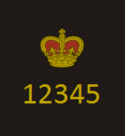 |  |  |  |  |
| Note |
| ||||||||
The City of London police also has a special constabulary with seven ranks of officers
| City of London Special Constabulary Ranks | |||||||||
|---|---|---|---|---|---|---|---|---|---|
| Rank | Standard Officers | Senior Officers | |||||||
| Special Constable | Special Sergeant | Special Inspector | Special Cheif Inspector | Special Superintendent | Special Chief Superintendent | Special Commander | |||
| Insignia |  |
 |
 |
 |
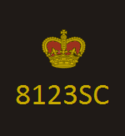 |
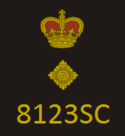 |
 | ||
| Note |
| ||||||||
As well as a PCSO rank
| Police Community Support Officer Rank | |
|---|---|
| Insignia | 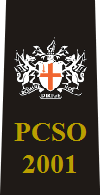 |
List of Commissioners
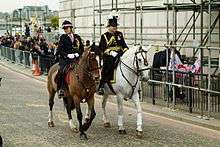
- Daniel Whittle Harvey (1839–1863)
- Colonel Sir James Fraser, KCB (1863–1890)
- Lieutenant-Colonel Sir Henry Smith, KCB (1890–1902)
- Captain Sir William Nott-Bower, KCVO (1902–1925)
- Lieutenant-Colonel Sir Hugh Turnbull, KCVO, KBE, KPM (1925–1950)
- Colonel Sir Arthur Young, KBE, CMG, CVO, KPM (1950–1971)
- James Page, QPM (1971–1977)
- Peter Marshall, QPM (1977–1985)
- Owen Kelly, QPM (1985–1994)
- William Taylor, QPM (1994–1998)
- Perry Nove, QPM (1998–2002)
- James Hart, QPM (2002–2006)
- Michael Bowron, QPM (2006–2011)[20]
- Adrian Leppard, QPM (2011–2015)
- Ian Dyson, QPM (2016–present)
Special Constabulary
Vehicles

The City of London Police has a fleet of vehicles including response cars, four-wheel-drive traffic vehicles, motorcycles, public order carriers, a horsebox (Scania P270), dog section vehicles and cage vans.
It has no independent marine capacity, and so relies on the Metropolitan Police Marine Policing Unit when its operational needs require such capacity.
Like all other forces in England and Wales, it relies on the National Police Air Service for its airborne capacity.
Officers killed in the line of duty
The Police Roll of Honour Trust[21] lists and commemorates all British police officers killed in the line of duty. The Police Memorial Trust since its establishment in 1984 has erected over 38 memorials to some of those officers.
Since 1857 31 active City of London Police staff have died; officers who died while attempting to prevent or stop a crime in progress include:[22]
- Sgt Robert Bentley, PC Walter Choat and Sgt Charles Tucker, 1910 (all fatally shot prior to the Siege of Sidney Street).
- Cmdr Hugh Moore QPM, 1993 (suffered heart failure following a violent arrest).
Olympics

Teams of the City of London Police have participated in the Olympic games three times in the tug of war tournament. At the 1908 Summer Olympics they won the gold medal, beating a team of the Liverpool Police in the final. In 1912 the team was beaten in the final by one of the Stockholm Police. At the 1920 Summer Olympics the team regained its title, beating the Netherlands. This was the last time tug of war was an Olympic sport, which means the City of London Police is still the reigning Olympic champion.[23][24]
Museum
The City of London Police Museum is dedicated to the police force and its story of policing.[25] Exhibits include uniforms, Victorian-era police equipment and artefacts, communication devices, World War II displays, and exhibits about Jack the Ripper and other famous murder cases.
The museum relocated in November 2016 to the space formerly used by the Clockmakers' Museum, next to the Guildhall Library.[26] The new museum was funded by a Heritage Lottery Fund grant.[27]
Other Corporation forces
The Corporation of London, the local authority for the City, also operates further police forces, including for territory outside the City.
City of London market constabularies
- City of London market constabularies — two of the three are outside the City
Hampstead Heath Constabulary
The Hampstead Heath Constabulary consists of 13 constables. From their inauguration until 24 May 2018 some constables worked with general purpose police dogs, all licensed to NPCC/Home Office standards. They have been responsible for patrolling the Heath since 1992.[28] The force also have red and white chequered sleeve and cap bands (red and white being the colours of the City of London), which in most other British police forces are black and white.
They are attested as constables under article 18 of the Greater London Parks and Open Spaces Order 1967[29] before a City of London magistrate. The City of London is not a relevant local authority for the purposes of the 1967 Act. However, the power to attest officers is enabled by article 5(1) of the London Government Reorganisation (Hampstead Heath) Order 1989,[30] which allows the City of London to exercise the same functions that the former Greater London Council had in relation to Hampstead Heath. This creates a legal anomaly in that the constabulary powers afforded by their attestation only relate to Hampstead Heath and cannot be exercised in any other park or open space under the control of the City of London.
In addition, the officers are also appointed with all the powers and privileges of a police constable under Section 16 of the Corporation of London Open Spaces Act 1878, which gives them the powers within any open space under the control of the City of London Corporation; other than Epping Forest, which is specifically excluded from the legislation. This additional power differentiates them from other parks constabularies, as it gives Heath officers full police powers within their jurisdiction. They enjoy full powers of a constable in relation to the bylaws and regulations, general law and specific legislation for open spaces. They work in close partnership with the Metropolitan Police, the territorial police force for Greater London, to which all serious criminal offences are passed for further investigation. They also maintain a close relationship with the City of London Police, who supply equipment and training to the service, further training is also supplied by Surrey Police.
The Heath Constabulary continue to use the term "Constabulary" rather than Parks Police to portray a more local and traditional aim of policing, but for those who are confused by the term the words "Policing Hampstead Heath" have been added to their vehicles to clarify their aim.
The constables are paid for out of charitable and private funds held by the City of London Corporation, and as such, their activity is not subject to the Freedom of Information Act.[31] This contrasts with the status of most other constables appointed within non-territorial police forces, such as port police.
Epping Forest Keepers
The Epping Forest Keepers are an ancient and historical body of people who are employed by the City of London, who in return are responsible, on behalf of the Conservators, for the management and care of Epping Forest, which covers approximately ten square miles of forest, bridleway, woodland and recreational space stretching from Forest Gate in east London, north to North Weald in Essex. The forest is managed by the City of London Corporation and is one of many open spaces that comes under their control that is outside the Square Mile[32] that are maintained by the Corporation of London at no expense to the tax payer.
There are currently nine Forest Keepers, three Senior Forest Keepers and one Head Keeper, each of whom is sworn in as a constable.[33]
In addition, the Superintendent of Epping Forest was attested as a constable in 2014.[34] The reason for the attestation related to both his involvement in incidents in the forest when going about his duties and to strengthen his role as a 'decision maker' in the instigation of proceedings for offences committed under the Epping Forest Act.
The powers of these powers relate exclusively to the enforcement of the Epping Forest Act 1878 and the byelaws made there under. Not all byelaws that are in operation within Epping Forest are made under that Act and the constables have no specific police power in order to enforce them. The constables also have no powers over and above those of a normal person to enforce criminal law, other than 'public justice offences' in relation to them exercising their police powers to enforce the Epping Forest Act (such as obstructing a constable, assaulting a constable or wasting police time in relation to making any false allegations of offences committed under the Epping Forest Act). Where this article may also refer to an "Epping Forest Constable" in places, it should be inferred that it refers to those Forest Keepers that have been attested as a constable.
Epping Forest is not a separate police area. The statutory responsibility for policing the forest rests either with the Metropolitan Police for parts of the forest within the Metropolitan Police District or Essex Police for the remainder of the forest located in the Essex Police area. However, there are times when the local police forces do not have geographical knowledge and that is where the forest keeper is most useful.
Section 45(1) of the Epping Forest Act clarifies that Epping Forest is a "place of public resort" (presumably to mean a "public place") and that the powers and duties of the Metropolitan Police and Essex Police extend therein (presumably to clarify that they have a duty to police it). This contrasts with the status of a council owned park which, whilst considered a public place when open, is in fact private property and the police would only have a responsibility to respond to incidents, rather than to patrol.
See also
- Fraud Squad
- Honourable Artillery Company
- Law enforcement in the United Kingdom
- List of police forces in the United Kingdom
- Project Griffin
References
- "City of London Police – Policing Plan 2017–20 (Year 3 2019/20)" (PDF). City of London Police. Retrieved 27 October 2019.
- "PEEL assessments".
- "Police Reform and Social Responsibility Act 2011". Government of the United Kingdom.
- "The police | Home Office". Government of the United Kingdom. Archived from the original on 27 October 2009. Retrieved 9 September 2010.
- "City of London appoints new Police Commissioner". City of London Corporation. 15 October 2015. Retrieved 22 January 2016.
- "Records of City of London Police Officers in CLRO" (PDF). Archived from the original (PDF) on 24 February 2011. Retrieved 8 June 2009.
- "City of London Police History – Key Dates". Retrieved 27 October 2019.
- Corporation of London (1999), "Memorandum by the Corporation of London (IT 134)", House of Commons Select Committee on Environment, Transport and Regional Affairs
- "New 'Ring of Steel' planned for London Square Mile". BBC. 24 December 2016. Retrieved 24 December 2016.
- "City of London Police – Economic Crime Directorate". City of London Police. 23 July 2010. Retrieved 9 September 2010.
- "DCPCU".
- "Insurance Fraud Enforcement Department".
- http://academy.cityoflondon.police.uk
- "City of London Police – International Corruption Unit". Retrieved 27 October 2019.
- "Uniforms and Buttons". Citypolice.tripod.com. Retrieved 9 September 2010.
- "Uniforms". Citypolice.tripod.com. Retrieved 9 September 2010.
- "Uniforms and Buttons". tripod.com.
- "City of London Police – tasers". Retrieved 27 October 2019.
- "Other Insignia". tripod.com.
- Widdup, Ellen (26 May 2009). "City police hire 50 specialists to fight £1 billion fraudsters". London Evening Standard. Archived from the original on 5 May 2013. Retrieved 1 January 2012.
- Trust, Police Roll of Honour. "Police Roll of Honour Trust".
- Police Roll of Honour Trust – City of London Police. Policememorial.org.uk. Retrieved 12 August 2013.
- "London 1908: Drugs, discord, cheating, boycotts and 56 gold medals for Britain". The Scotsman. Retrieved 6 May 2009.
- "City Police history". City of London Police. Retrieved 6 May 2009.
- City of London Police Museum website
- "London gets a new museum – of police history". IanVisits. 27 November 2016.
- "Inside London's quirkiest new museum". The Daily Telegraph. 3 November 2016.
- "Hampstead Heath Constabulary Annual Report 2015-16". Retrieved 1 October 2016.
- The 1967 order is scheduled to the Ministry of Housing and Local Government Provisional Order Confirmation (Greater London Parks and Open Spaces) Act 1967
- London Government Reorganisation (Hampstead Heath) Order 1989.
- "Archived copy" (PDF). Archived from the original (PDF) on 1 February 2014. Retrieved 21 January 2014.CS1 maint: archived copy as title (link)
- The City of London Corporation also manage: Burnham Beeches, City Common, Hampstead Heath, Highgate Woods, Queens Park and West Ham Park http://www.cityoflondon.gov.uk/things-to-do/green-spaces/Pages/default.aspx
- Report: Authorisation of an Epping Forest Officer (13 May 2013) http://democracy.cityoflondon.gov.uk/documents/s20217/SEF%208-13%20Authorisation%20of%20FK%202013%20GM%20FINAL.pdf See p.2, paragraph 9
- 4929102410159002